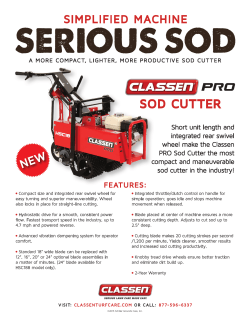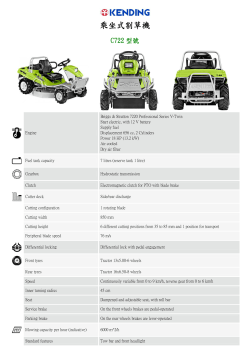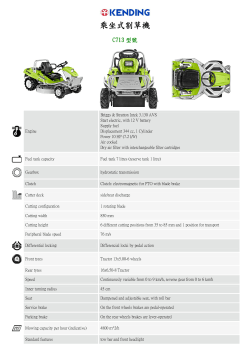
Assembly Manual - Lumber Smith
Lumber Smith Assembly Manual If you are having problems assembling the saw and need assistance, please contact us at: 804-577-7398 info@lumbersmith.com Step 1 – Safety Carefully read the Owners Manual. As with all machinery, there are certain hazards involved with the operation of this product. The combination to the lock on the motor mount can be found in the safety instructions portion of the owners manual. Step 2 – Lay out your Parts Open all of the packaging and lay out the parts. Assembling the sawmill will take 2-3 hours. Skipping steps will make it harder. Wear gloves and eye protection when handling the blade. Step 3 – Gather your Tools Although other tools may make assembling the sawmill easier, you only need: • • • • • • • • 7/16” wrench 1/2” wrench 9/16” wrench 5/32” hex key (provided) 3/16” hex key (provided) Torpedo level (provided) Pliers Hammer Step 4 – Attaching the Wheels Place a 3/4” washer on all four axles, followed by the black plastic wheel, another washer, and finally the hitch pin. Step 5 – Installing the Locking Handles The locking handles are used to clamp the stainless steel locking plates to the legs during operation. Note how the head of the bolt is held captive by the aluminum casting and the galvanized tubing holds the handle away from the locking plate. Step 6 – Installing the Legs Loosen the locking handles and slide the legs into the channel on the cast aluminum frame. It may be necessary to slack the four 5/16-18 bolts on the locking plates to provide clearance. Tighten the locking handles so the saw frame is held on the legs via friction. Notice the orientation of the legs. There is a right and a left leg and the wheels are on the outside of the sawmill. Step 7 – Installing the Lift Assembly The lift assembly allows you to raise and lower the sawmill via threaded rod and a hand crank. This makes it easy to determine how far the blade has advanced. First, place the two cast aluminum lift caps in the top of the square tubing. Notice how the hole lines up with the cutout in the locking plate. Next, loosen the locking handles and raise the saw frame to within approximately 2 inches of the bottom of the lift caps. Tighten the locking handles. Thread the black plastic nuts approximately 4.5” from the end of the threaded rod. Step 7 – Installing the Lift Assembly Insert the threaded rod from underneath the locking plate and up through the lift cap. Notice how the plastic nut fits tightly between the two tines on the locking plate. Bend the tines with a pair of pliers so the nut is held tightly if there is excessive slop. Place the thin black plastic washer on the lift cap and then place the lift handle on the threaded rod. Make sure it is fully seated and tighten the set screw. Hold the black plastic nut in the tines of the locking plate and crank out the slack with the lift handles. Now you can loosen the locking handles without the saw frame crashing down to the ground. Step 8 – Lubricating the Motor See the lubrication requirements in the Honda owners manual. Running the motor without oil in the crank case and gearbox will result in severe damage. Woodwrights LLC is not responsible for damage due to insufficient lubrication. Step 8 – Installing the Motor Mount Remove the nut and two washers from the four 3/8-16 bolts and insert them through the holes in the cast aluminum saw frame. Notice how the casting holds the heads of the bolts captive. On the other side of the casting, place the four black plastic washers over the bolts. Step 8 – Installing the Motor Mount Carefully place the motor mount over the four bolts. Place the steel washers and nuts on the bolts and snug them down. Next, loosen the four nuts approximately 1/8 of a turn. The motor mount MUST be able to slide left and right with firm finger pressure for the saw to function properly. The motor mount must be able to slide left and right with firm finger pressure. Step 8 – Installing the Motor Mount Notice the slot pattern on the bottom surface of the motor mount and how the motor will pivot on the top right bolt. This will be used to adjust the pitch of the drive wheel later. Place the motor on the motor mount and install the four 5/16-18 bolts and washers. Just as before, don't fully tighten the bolts. The motor will need to be pivoted later to adjust how the blade tracks on the wheels. Step 9 – Installing the Yoke Remove the two washers, tubing, and nut from the yoke. Insert the threaded rod through the hole in the frame and slip the bearing over the motor's shaft. Install the washers, tubing, and nut on the outside of the frame. Tightening the nut will pull the motor and motor mount to the left, thus tensioning the blade. That is why it is critical the motor mount be able to slide on the frame. Step 10 – Installing the Drive Wheel Place Loctite 609 in the keyway and all around the shaft. Place the drive wheel on the shaft with the machined side of the hub out. Rotate the drive wheel a few times to distribute the Loctite around the shaft. Install the key into the keyway and overhang the drive wheel on the shaft approximately 1/8” Tighten the three setscrews. Don't forget the one in the back! Step 11 – Installing the Motor Pivot Bolt Notice how the motor pivots in relation to the cast aluminum saw frame. This is how the pitch of the drive wheel is adjusted. Changing the pitch of the drive wheel changes how the blade tracks on the wheels. Pivoted Fully Counter Clockwise Pivoted Fully Clockwise Place the 1/4-20 x 5” bolt through the hole in the side of the motor mount. Looking down on the top of the motor, rotate it fully counter clockwise. Thread the nut up the bolt until it is held captive by the notch in the motor mount. Place the end of the bolt near the oil drain plug so that it pushes on the motor. The purpose of this bolt is to hold the motor's position until the four mounting bolts can be fully tightened. Step 12 – Putting on the Blade Wear gloves when handling the blade! The teeth are very sharp. Use caution when installing the blade, it is like a large spring and can spring off of the wheels. Tie a piece of rope around the saw frame to prevent the blade from hitting your face. Wear safety glasses. 2 3 1 4 5 1. Loosen the nut on the yoke so the motor mount may slide freely. 2. Push the motor, motor mount, and drive wheel as far to the left as possible. 3. Ensure the blade guides will not interfere with the blade. Loosen and move them up out of the way if they do. 4. Ensure the back bearings will not interfere with the blade. Loosen and move them to the bottom of the slot if they do. 5. Make sure the teeth on the blade are cutting towards the drive wheel. Step 13 – Tensioning the Blade Proper tension must be put on the blade for the saw to operate effectively. Using the included tie wire, tie a gallon (3.785 liters) of water to the center of the blade. Place the tension gauge on top of the blade. Notice how the gallon of water pulls the blade away from the center of the gauge. This blade does not have enough tension. If the blade is too loose, tighten the nut on the yoke with a 1/2” wrench. Frequently check the tension with the gauge. If the gauge touches only near the center, the blade is over tensioned. Reduce tension by loosening the nut on the yoke with a 1/2” wrench. The blade is properly tensioned when the gauge touches the blade evenly. Remove the jug of water. Step 13 – Adjusting the Wheels Vertically The drive and idle wheels need to be in the same plane for the blade to track properly. Another way to put it is that the axles for the drive and idle wheels must be parallel. This is complicated by the fact that the cast aluminum saw frame bows slightly when the blade is tensioned. Therefore it is critical that this step is done after the blade is properly tensioned. Screw the two aluminum pieces to the 2x4 with the included screws to fashion a jig. Place it on a flat surface and ensure it does not rock. The accuracy of this jig will determine the accuracy of your saw. Place the jig on the drive wheel so that it touches both the top and bottom edges of the wheel. Step 13 – Adjusting the Wheels Vertically A Look at the idle wheel side and note where the jig touches the wheel. If it touches at point A and not at point B, tighten bolt 1. If it touches at point B and not at point A, loosen bolt 1. B The goal is to have the jig touch the wheels at all four points. Bolt 1 Step 14 – Adjusting the Wheels Horizontally D Use the long jig to check the wheel's alignment horizontally. C Place the jig so that points A and B touch the drive wheel. B Points C and D should not touch anything at this time. A Begin to loosen the motor pivot bolt with a 7/16” wrench. This will allow the motor to pivot clockwise as viewed from the top. Frequently check with the horizontal adjustment jig until point C touches. Do not allow the 1/4-20 bolt to “walk” to the bottom of the motor and slip off. It is almost impossible to tighten the 1/4-20 bolt and force the motor counterclockwise, so don't let the motor pivot too far! Step 14 – Adjusting the Wheels Horizontally If the jig hits point D before point C, it will be necessary to tighten Nut 1 and continue loosening the motor pivot bolt until the jig touches point C. Now that points A, B, and C are in alignment, it's time to bring point D into alignment. Loosen Nut 1 to allow the idle wheel plate to swing outward closer to the jig. If it jams, tap it with a block of wood until the washer is against the frame. Both wheels should now be in the same plane. Nut 2 Nut 1 Nut 2 should never be adjusted. The nut should be left flush with the end of the bolt. Nut 1 is delivered from the factory with four threads showing past the end of the nut. That's a safe place to start if you need to redo the adjustment process. Step 15 – Testing the Blade Tracking If you are satisfied the wheels are aligned vertically and horizontally as well as possible, tighten down the four 5/16-18 motor mounting bolts. DO NOT run the saw without tightening these bolts! After the motor mounting bolts are tightened, turn the switch off and disconnect the spark plug. Pull the starting cord half a dozen times to advance the blade. On a properly adjusted saw, the gullet of the blade will ride just off of the wheels. Loosening Nut 1 will cause the blade to move forward, showing more teeth. Tightening it will do the reverse. Pull the starting cord after each small adjustment. Step 16 – Adjusting the Pitch of the Blade At this point the blade should be properly tensioned and the blade tracks on the wheels. Now it's time to adjust the pitch of the blade so that it will not have a tendency to dive or climb in the cut. Place the included torpedo level on the leg of the saw. Notice how the bubble is touching the first line on the right. That is because the ground isn't perfectly level. Make a note of the bubble's position and place it on the blade near the drive wheel. Make sure the level is on a raker tooth or one that is bent downwards. Otherwise the tooth will affect the level's reading. The bubble is centered so the blade's pitch should be adjusted until the bubble touches the first line. Loosen the plate holding the brass blade guide. Use firm finger pressure to push the guide against the blade. Use the provided hex key to rotate the blade guide until the bubble matches where it was when the torpedo level was on the leg. Tighten the plate and move the level near the idle wheel. Repeat the process for the idle wheel side blade guide. Step 17 – Adjusting the Blade Back Bearings As you cut, the log will push the blade backwards. The blade back bearings counteract this force reducing the stress on the idle wheel bearings and motor shaft. Use a 9/16” wrench and provided hex key to loosen the nut on the back of the saw. Slide the entire back bearing assembly in the slot as high as possible. Do not raise the assembly so high that the blade rubs against the nut on the inside. Use the hex key to adjust the bearing's position until there's a business card width between the blade and the bearing. Tighten the nut on the back side to lock the assembly in place. Repeat this process for the other back bearing assembly. Step 18 – Installing the Drip Kit The drip kit helps cool the blade, reduce sap and pitch buildup, and improve cutting speed. The blade wipe oils the blade to remove debris and reduce rusting. Saturate the felt wipe in oil and fill the plastic container with oil. Mount the blade wipe and oil reservoir on the bracket. It my bend the blade upwards a bit at first, but it will soon be trimmed to the right size. Strap the canvas bag to the saw frame and thread the tubing through the hole. Position it just above the blade on the inside. Fill the rubber bladder with water and adjust the valve so that it drips 2-3 times per second. Step 18 – Put on the Cover Put on the cover, read the safety manual again, and go cut some lumber!
© Copyright 2025









